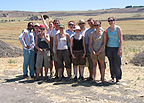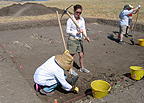September 12, 2007
Field school unearths details about ancient Romans

(Editors: Note hometown names)
Caption follows story
CARBONDALE, Ill. — To understand ancient life during the days of the Roman Empire, Southern Illinois University Carbondale bioarchaeologist Tracy Prowse goes directly to the ancient Romans themselves.
This summer, SIUC conducted its first-ever bioarchaeological field school at the Roman site of Vagnari, near the modern city of Gravina in the Puglia region of Italy, which is the "heel" peninsula of the Italian "boot." Three SIUC students joined Prowse for the month of July to uncover an ancient cemetery and learn what they could from the burial site, the grave goods and from the skeletons themselves. Four students from other universities also joined the SIUC team at the site.
"We found about 18 burials," Prowse said. "I was fairly certain there were burials where we were digging, but there's always a chance we won't find anything."
Prowse first excavated at the site in 2002, and has been there every year since. She said the area is a farm field most of the year. When the land is fallow during the off-season, though, the landowner permits archaeological excavation.
The Vagnari site dates to the second and third centuries A.D. Prowse and her team found two types of graves in the cemetery. One type, called a libation burial, supports evidence from historical sources that Romans offered food and drink to the dead. Many of the burials contained grave goods, including pottery and glass vessels, jewelry, lamps, coins and iron. And a more recent local custom seems to have a precedent in ancient times, Prowse said. Her team found the skeletal remains of a girl about 10 or 12 years old. Beads, rings and other artifacts seem to indicate that she was given special treatment when buried. Possibly she was dressed as a bride, as was the custom with young girls who died before marriageable age in historic Gravina, according to local historians, Prowse said.
Examining the skeletons provides more clues to the mystery of reconstructing long-ago lives. For example, evidence of fractures and arthritis in many of the skeletons – and the proximity of the cemetery to a neighboring archaeological site that was once an ancient Roman villa – indicates those in the cemetery were laborers. Prowse hopes to determine if the people were native to the area or if they were brought there through Imperial conquest. Clues are in the molars, she said. The first molar develops when a person is a child, leaving, for those who know how to read it, a record of where a person lived when very young. If the third molar, which develops significantly later, is significantly different, that indicates a change of environment, Prowse said.
Prowse and her team also send organic samples to the McMaster (University) Palaeogenetics Institute, a university laboratory focusing on the study and analysis of ancient DNA. Prowse wants to know if the people in the cemetery – particularly those buried near each other – were related to each other. Still more skeletal analysis provides clues into the diet of the people and some hints about possible climatic changes in their environments.
"We really don't know a lot about rural Romans. Most of what we know is from the urban centers," Prowse said. "It's about reconstructing the lives of these people – how they lived, what they ate, what they did."
SIUC students participating in the bioarchaeological field school at Vagnari for 2007 were:
Teaching assistant Kyle Lubsen, a graduate student from Northport, Ala.
Chrystal Nause, a graduate student from Makanda.
Josh Robin, an undergraduate student from Flossmoor.
The following students from other universities also participated in the 2007 SIUC Bioarchaeological Field School:
Tia Buto, an undergraduate student at the University of Central Florida.
Melissa Smith, an undergraduate student at the University of Central Florida.
Rebecca Furnell, a graduate student at the University of Toronto, Canada.
Catherine Peterson, a graduate student at McMaster University, Canada.

Caption follows story

Caption follows story
Caption:
Vagnari crew 2007 – The entire crew from the 2007 Southern Illinois University Carbondale Bioarchaeological Field School at Vagnari for 2007. Two other archaeological sites were also under excavation at the time of the SIUC excavation. Students visited each other’s sites at least once during the month-long dig.
Photo provided
Diggers – Chrystal Nause and Josh Robin from Southern Illinois University Carbondale get some help from another archaeological student at the Vagnari site during the SIUC Bioarchaeological Field School. The beautiful southern Italian countryside provides a lovely backdrop for their hard work.
Photo provided
What they did last summer – Tia Buto, kneeling, and Melissa Smith, undergraduate students at the University of Central Florida, spent a month this summer near the southern Italian town of Gravina as they participated in the Southern Illinois University Carbondale 2007 Bioarchaeological Field School at Vagnari. Some Ancient Roman graves are visible behind the students.
Photo provided
